+ Open data
Open data
- Basic information
Basic information
| Entry | Database: PDB / ID: 7rnn | ||||||
|---|---|---|---|---|---|---|---|
| Title | Human ASIC1a-Nb.C1 complex | ||||||
 Components Components |
| ||||||
 Keywords Keywords | MEMBRANE PROTEIN / Channel Proton-gated Nanobody | ||||||
| Function / homology |  Function and homology information Function and homology informationmonoatomic ion-gated channel activity / sensory perception of sour taste / pH-gated monoatomic ion channel activity / cellular response to pH / negative regulation of neurotransmitter secretion / response to acidic pH / neurotransmitter secretion / ligand-gated sodium channel activity / sodium ion transport / associative learning ...monoatomic ion-gated channel activity / sensory perception of sour taste / pH-gated monoatomic ion channel activity / cellular response to pH / negative regulation of neurotransmitter secretion / response to acidic pH / neurotransmitter secretion / ligand-gated sodium channel activity / sodium ion transport / associative learning / regulation of postsynapse assembly / behavioral fear response / sodium ion transmembrane transport / response to amphetamine / regulation of membrane potential / postsynaptic density membrane / calcium ion transmembrane transport / Stimuli-sensing channels / memory / presynapse / dendrite / glutamatergic synapse / cell surface / Golgi apparatus / plasma membrane Similarity search - Function | ||||||
| Biological species |   Homo sapiens (human) Homo sapiens (human) | ||||||
| Method | ELECTRON MICROSCOPY / single particle reconstruction / cryo EM / Resolution: 2.86 Å | ||||||
 Authors Authors | Wu, Y. / Chen, Z. / Sigworth, F.J. / Canessa, C.M. | ||||||
| Funding support |  United States, 1items United States, 1items
| ||||||
 Citation Citation |  Journal: Elife / Year: 2021 Journal: Elife / Year: 2021Title: Structure and analysis of nanobody binding to the human ASIC1a ion channel. Authors: Yangyu Wu / Zhuyuan Chen / Fred J Sigworth / Cecilia M Canessa /   Abstract: ASIC1a is a proton-gated sodium channel involved in modulation of pain, fear, addiction, and ischemia-induced neuronal injury. We report isolation and characterization of alpaca-derived nanobodies ...ASIC1a is a proton-gated sodium channel involved in modulation of pain, fear, addiction, and ischemia-induced neuronal injury. We report isolation and characterization of alpaca-derived nanobodies (Nbs) that specifically target human ASIC1a. Cryo-electron microscopy of the human ASIC1a channel at pH 7.4 in complex with one of these, Nb.C1, yielded a structure at 2.9 Å resolution. It is revealed that Nb.C1 binds to a site overlapping with that of the Texas coral snake toxin (MitTx1) and the black mamba venom Mambalgin-1; however, the Nb.C1-binding site does not overlap with that of the inhibitory tarantula toxin psalmotoxin-1 (PcTx1). Fusion of Nb.C1 with PcTx1 in a single polypeptide markedly enhances the potency of PcTx1, whereas competition of Nb.C1 and MitTx1 for binding reduces channel activation by the toxin. Thus, Nb.C1 is a molecular tool for biochemical and structural studies of hASIC1a; a potential antidote to the pain-inducing component of coral snake bite; and a candidate to potentiate PcTx1-mediated inhibition of hASIC1a in vivo for therapeutic applications. | ||||||
| History |
|
- Structure visualization
Structure visualization
| Movie |
 Movie viewer Movie viewer |
|---|---|
| Structure viewer | Molecule:  Molmil Molmil Jmol/JSmol Jmol/JSmol |
- Downloads & links
Downloads & links
- Download
Download
| PDBx/mmCIF format |  7rnn.cif.gz 7rnn.cif.gz | 106.1 KB | Display |  PDBx/mmCIF format PDBx/mmCIF format |
|---|---|---|---|---|
| PDB format |  pdb7rnn.ent.gz pdb7rnn.ent.gz | 73.9 KB | Display |  PDB format PDB format |
| PDBx/mmJSON format |  7rnn.json.gz 7rnn.json.gz | Tree view |  PDBx/mmJSON format PDBx/mmJSON format | |
| Others |  Other downloads Other downloads |
-Validation report
| Summary document |  7rnn_validation.pdf.gz 7rnn_validation.pdf.gz | 813.2 KB | Display |  wwPDB validaton report wwPDB validaton report |
|---|---|---|---|---|
| Full document |  7rnn_full_validation.pdf.gz 7rnn_full_validation.pdf.gz | 817.2 KB | Display | |
| Data in XML |  7rnn_validation.xml.gz 7rnn_validation.xml.gz | 21.7 KB | Display | |
| Data in CIF |  7rnn_validation.cif.gz 7rnn_validation.cif.gz | 31.3 KB | Display | |
| Arichive directory |  https://data.pdbj.org/pub/pdb/validation_reports/rn/7rnn https://data.pdbj.org/pub/pdb/validation_reports/rn/7rnn ftp://data.pdbj.org/pub/pdb/validation_reports/rn/7rnn ftp://data.pdbj.org/pub/pdb/validation_reports/rn/7rnn | HTTPS FTP |
-Related structure data
| Related structure data |  24580MC M: map data used to model this data C: citing same article ( |
|---|---|
| Similar structure data |
- Links
Links
- Assembly
Assembly
| Deposited unit | 
|
|---|---|
| 1 |
|
- Components
Components
| #1: Antibody | Mass: 12762.210 Da / Num. of mol.: 1 Source method: isolated from a genetically manipulated source Source: (gene. exp.)   | ||||
|---|---|---|---|---|---|
| #2: Protein | Mass: 60001.309 Da / Num. of mol.: 1 Source method: isolated from a genetically manipulated source Source: (gene. exp.)  Homo sapiens (human) / Cell line: HEK293T / Gene: ASIC1, ACCN2, BNAC2 / Plasmid: pcDNA3.1 / Cell line (production host): HEK293F / Production host: Homo sapiens (human) / Cell line: HEK293T / Gene: ASIC1, ACCN2, BNAC2 / Plasmid: pcDNA3.1 / Cell line (production host): HEK293F / Production host:  Homo sapiens (human) / References: UniProt: P78348 Homo sapiens (human) / References: UniProt: P78348 | ||||
| #3: Sugar | | Has ligand of interest | Y | Has protein modification | Y | |
-Experimental details
-Experiment
| Experiment | Method: ELECTRON MICROSCOPY |
|---|---|
| EM experiment | Aggregation state: PARTICLE / 3D reconstruction method: single particle reconstruction |
- Sample preparation
Sample preparation
| Component | Name: Human ASIC1a in complex with Nb.C1 / Type: COMPLEX / Entity ID: #1-#2 / Source: RECOMBINANT | |||||||||||||||||||||||||
|---|---|---|---|---|---|---|---|---|---|---|---|---|---|---|---|---|---|---|---|---|---|---|---|---|---|---|
| Molecular weight | Units: KILODALTONS/NANOMETER / Experimental value: NO | |||||||||||||||||||||||||
| Source (natural) | Organism:  Homo sapiens (human) Homo sapiens (human) | |||||||||||||||||||||||||
| Source (recombinant) | Organism:  Homo sapiens (human) Homo sapiens (human) | |||||||||||||||||||||||||
| Buffer solution | pH: 7.4 Details: Solutions were filtered with 0.22um to avoid contamination. | |||||||||||||||||||||||||
| Buffer component |
| |||||||||||||||||||||||||
| Specimen | Conc.: 3.8 mg/ml / Embedding applied: NO / Shadowing applied: NO / Staining applied: NO / Vitrification applied: YES / Details: This sample was monodisperse. | |||||||||||||||||||||||||
| Specimen support | Grid material: GOLD / Grid mesh size: 300 divisions/in. / Grid type: Quantifoil R1.2/1.3 | |||||||||||||||||||||||||
| Vitrification | Instrument: FEI VITROBOT MARK III / Cryogen name: ETHANE / Humidity: 100 % / Chamber temperature: 298 K / Details: blot for 3s before plunging |
- Electron microscopy imaging
Electron microscopy imaging
| Experimental equipment |  Model: Titan Krios / Image courtesy: FEI Company |
|---|---|
| Microscopy | Model: FEI TITAN KRIOS / Details: Preliminary grid screening was performed manually |
| Electron gun | Electron source:  FIELD EMISSION GUN / Accelerating voltage: 300 kV / Illumination mode: FLOOD BEAM FIELD EMISSION GUN / Accelerating voltage: 300 kV / Illumination mode: FLOOD BEAM |
| Electron lens | Mode: BRIGHT FIELD / Nominal magnification: 105000 X / Nominal defocus max: 2000 nm / Nominal defocus min: 1000 nm / Cs: 2.7 mm / C2 aperture diameter: 100 µm |
| Specimen holder | Cryogen: NITROGEN / Specimen holder model: FEI TITAN KRIOS AUTOGRID HOLDER |
| Image recording | Average exposure time: 1.4 sec. / Electron dose: 45 e/Å2 / Film or detector model: GATAN K3 (6k x 4k) / Num. of grids imaged: 2 / Num. of real images: 7318 |
- Processing
Processing
| EM software |
| ||||||||||||||||||||||||||||||||||||||||
|---|---|---|---|---|---|---|---|---|---|---|---|---|---|---|---|---|---|---|---|---|---|---|---|---|---|---|---|---|---|---|---|---|---|---|---|---|---|---|---|---|---|
| Image processing | Details: The selected images were high-pass filtered and normalized. | ||||||||||||||||||||||||||||||||||||||||
| CTF correction | Type: NONE | ||||||||||||||||||||||||||||||||||||||||
| Particle selection | Num. of particles selected: 1287029 / Details: Template (emd_7009) based particle picking. | ||||||||||||||||||||||||||||||||||||||||
| Symmetry | Point symmetry: C3 (3 fold cyclic) | ||||||||||||||||||||||||||||||||||||||||
| 3D reconstruction | Resolution: 2.86 Å / Resolution method: FSC 0.143 CUT-OFF / Num. of particles: 84500 / Algorithm: FOURIER SPACE / Num. of class averages: 1 / Symmetry type: POINT | ||||||||||||||||||||||||||||||||||||||||
| Atomic model building | B value: 200 / Protocol: RIGID BODY FIT / Space: REAL / Target criteria: Correlation coefficient | ||||||||||||||||||||||||||||||||||||||||
| Atomic model building | 3D fitting-ID: 1 / Pdb chain-ID: A / Source name: PDB / Type: experimental model
|
 Movie
Movie Controller
Controller



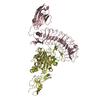
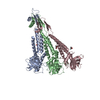
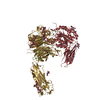
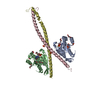
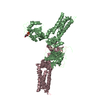
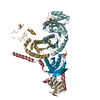
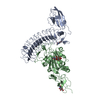
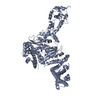
 PDBj
PDBj





